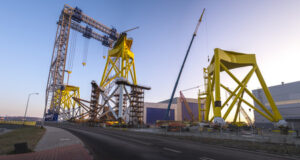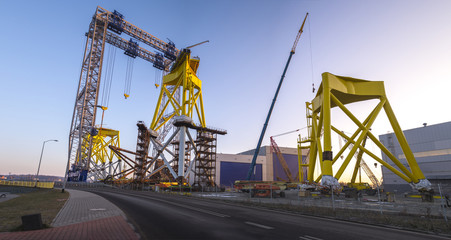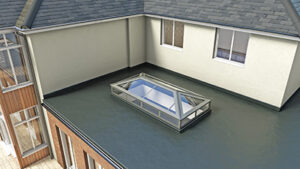Foundation piers are crucial components in the repair of a settling house. They are driven deep into the soil to a point of refusal or bedrock, providing crucial support for your home and eliminating settling problems.
Foundation experts measure turning resistance as a pier is driven to determine when it has reached competent load-bearing soil. This allows them to install piers quickly and efficiently. Contact Pier Installation Near Me for professional help.
Piers can be installed much faster than traditional methods of foundation repair. This makes them one of the most cost-effective repairs for your home’s structural issues. Additionally, fewer excavation steps and time spent on construction means less property disruption and landscaping disruption.
Concrete pressed piers are one of the most popular foundation repair methods in the DFW area. They are used to stabilize and in some cases raise slab foundations that have settled. This is because they are driven into the settlement zone deep enough to contact competent load-bearing soil or bedrock. A heavy-duty bracket then connects the pier to the slab, stabilizing or raising it back into place.
With their incredible load-bearing capacity, resistance piers are one of the most durable and reliable solutions for your home. Their steel construction and deep driving depth allow them to withstand the weight of your home, including basements and crawl spaces. They are also load-tested during installation to ensure that they have reached their maximum capacity.
These piers are drilled into the ground using hydraulically powered rigs, and they’re driven with interlocking sections that increase their strength and reliability. They are also a great option for homes with sagging concrete porches or decks because they can lift them up to their original position. This non-invasive repair method is the fastest way to stabilize and lift a slab foundation, which reduces costs and disruption to your landscape.
A helical pier is another fast and efficient solution for your home’s foundation problems. They’re shaped like corkscrews and turned into the soil by a hydraulic rig, which ensures they reach the load-bearing layer. They’re more affordable than other pier types, offer flexible customization options, and can be installed in all soil types.
Unlike concrete piers, interior piers can be installed from inside your home. This eliminates the need for excavation and allows the contractors to work faster, which means they can get your foundation repaired sooner. It also saves money because there’s no need to wait for the concrete to dry before beginning framing. This is a great choice for older homes or homes with unique soil conditions that prevent the use of other pier repair methods.
Less Excessive Excavation
Piers screw into the ground to provide deep support, so less soil needs to be removed than other foundation types. This allows for easier installation in confined spaces, and it also minimizes the disruption to landscaping and natural environments around the home. The reduced environmental footprint of piers helps to reduce carbon emissions, and it also saves homeowners money on the cost of re-landscaping and other restoration activities that are usually required after traditional foundation methods have been used.
Traditional foundations require a large amount of concrete, which means it takes a lot of resources to produce and place. Steel piers, on the other hand, can be installed with smaller machinery that uses less fuel. The resulting lower carbon emissions can make a significant difference in the environment and contribute to a healthier planet.
During the excavation process, contractors may need to drive temporary casing into the soil in order to shore up caving soils and prevent the aggregate used for the pier from becoming contaminated with soil. The process can be extremely difficult, but it is important to ensure that the soil surrounding the pier is clean and free of contamination before installing it.
After excavation, the contractor will need to backfill the soil around the pier and fill any areas that were displaced. This can be time consuming and expensive, but it is a necessary step to ensure that the piers stay in place and that the soil is stable.
Many homeowners choose to install decking over the pier, which provides an excellent surface for setting up telescopes and observatory equipment. This can save a lot of time in the set up process and it can also help to eliminate vibration, which is often a problem with telescopes.
Once the decking is installed, it is possible to polar align the telescope and begin taking pictures or observations. The decking can also protect the pier from water and other contaminants, which can cause damage over time. Lastly, it can help to prevent debris from settling under the telescope, which can interfere with the performance of the equipment.
Less Damage to the Soil
The process of digging pier holes and pouring concrete is damaging to the soil. The concrete can be abrasive and scrape the soil, which can leave it weaker or damaged after the repairs are complete. Using helical piers instead eliminates this problem because the helical blades drive into the soil without causing any damage. This is also a much more environmentally friendly option. Instead of pouring a large amount of concrete that is contaminated with carbon emissions, helical piers use steel that requires less energy to manufacture.
Traditional foundation methods require a lot of concrete, which means it takes a long time to create the material and transport it to the construction site. This can damage the surrounding environment as well. In addition, the cement used in the foundation is heavy and can cause damage to surrounding structures and vegetation. Compared to this, helical piers only need a small amount of concrete to support your foundation, which protects the environment.
Unlike traditional concrete foundations, helical piers are less likely to move over time. This is because they lock deep into the soil and are above frost depths. In contrast, concrete foundations may move as water content fluctuates between extreme conditions like excessive rainfall and drought. This can change the load bearing capacity of the soil causing foundation movement.
In addition, helical piers can be moved around to accommodate changing soil conditions. This makes them a more versatile solution for homeowners. For instance, if you decide to add a sunroom to your home in the future, helical piers can be relocated to support both the basement and new structure. This gives helical piers a major advantage over traditional concrete piers.
If you are considering a pier and beam foundation for your home, be sure to consult with an expert. A foundation repair specialist will be able to provide you with a full assessment of your situation and recommend the best approach for repairing your foundation. They can also help you determine whether a pier and beam foundation or a hybrid system is the right choice for your home.
Less Damage to the Foundation
The installation of piers is designed to minimize damage to the foundation itself, and to the home. However, it is not a completely foolproof method of foundation repair. If the piers are installed in the wrong location, they will not be able to lift and stabilize the entire foundation.
The most common way to install piers is by tunneling under the foundation. In this method, technicians dig tunnels at regular intervals from one end of the foundation to the other. This allows the contractors to reach the weakened soil underneath the foundation without damaging your flooring or causing other costly structural damage.
It also provides a chance for the foundation to be lifted by the piers without being damaged. In addition, the tunneling technique reduces pier installation costs by cutting down on labor expenses. The piers themselves are made of heavy steel, which is less likely to be damaged by the vibrations of the digging process.
Another reason to consider piers is their ability to penetrate into weak or unstable soil. Unlike concrete piers, which are often confined by the depth of their footing, helical piers can be driven deeper into the soil. By measuring the turning resistance as they are driven, the contractors can tell when the pier has reached competent load-bearing soil.
This enables them to lift and stabilize the structure of your house more quickly than other types of piers. In addition, helix piers can be used to stabilize a garage or a sinking basement. They can even be drilled at an angle to straighten a bowing wall.
While helix piers are effective at lifting and stabilizing your foundation, they cannot replace a solid, well-built concrete slab. This is why it’s important to choose a foundation repair company with experience installing both pier and slab foundations.
It’s also a good idea to talk to your contractor about financing options. Many companies offer in-house financing to help homeowners bring the upfront cost of pier repair down. This helps them avoid the stress of paying for a major home improvement at once and makes it easier to manage their budgets over time.



